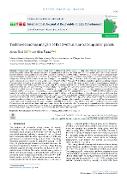| dc.contributor.author | Gol, Akram Elahi | |
| dc.contributor.author | Ščasný, Milan | |
| dc.date.accessioned | 2024-05-15T09:10:44Z | |
| dc.date.available | 2024-05-15T09:10:44Z | |
| dc.date.issued | 2023 | |
| dc.identifier.uri | https://hdl.handle.net/20.500.14178/2471 | |
| dc.description.abstract | The potential output of photovoltaic (PV) panels is influenced by several factors, including the direction of solar radiation from the sun toward the panel's surface. The maximum output of the panels is obtained when the panels are vertical to the sun's rays. In this study, a techno-economic analysis is conducted to examine whether an automatic one-axis sun tracker system is an economically feasible option for installing a large-scale PV park in the Nicosia district in the central part of Cyprus. The performance of a one-axis sun tracker with an installed capacity of 781 kWp is compared to a PV system with a fixed flat structure having the same capacity and larger capacity at 1034 kWp. Output generated by the three PV system options is simulated by three alternative simulation software (SolarGIS, PVSyst, and PVGIS). Financial analysis is performed utilizing simulated PV power output, accounting for electricity feed-in tariff and overall cost of the project. The cash-flow model is run for several scenarios defined by different leverage ratios, including no leverage. Considering the technical parameters of a PV system and solar panel characteristics, such as the degradation effect on solar panel efficiency and solar radiation, we estimate the solar tracking system produces about 20%-30% more energy compared to a fixed structure. We find both technologies are economically viable options, however, a one-axis tracker system performs better financially. LCOE in all scenarios is below the highest acceptable level for solar PV projects in Cyprus which is 103 EUR per MWh. LCOE for a solar tracker PV is 39 EUR per MWh with a 30% leverage ratio and up to 79 EUR per MWh with 85% leverage. LCOE for a sun-tracker is similar to 20% lower than LCOE for a PV with a fixed axis of comparable size. Despite higher investment costs, the solar tracking PV system performs with a 12% higher equity internal rate of return, and a 9% shorter loan payback period compared to the same installed power of a fixed structure. The Financial analysis is complemented by quantified benefits due to avoided carbon emissions. Accounting for carbon benefits makes a sun-tracker PV system economically a better option over the fixed tracker PV system, resulting in 228,000 EUR more benefits. Overall, the present value of net benefits of a solar-tracker PV amounts to 1.39 mil. EUR and due to high irradiation in Cyprus, the carbon footprint of PV power output represents only 6% of the footprint of generating electricity in thermal power plants. When these benefits are accounted for the sum of NPV and social benefits will turn out to be higher for a one-axis tracker compared to the total social benefits of a fixed tracker of the same size. | en |
| dc.language.iso | en | |
| dc.relation.url | https://doi.org/10.14710/ijred.2023.50165 | |
| dc.rights | Creative Commons Uveďte původ-Zachovejte licenci 4.0 International | cs |
| dc.rights | Creative Commons Attribution-ShareAlike 4.0 International | en |
| dc.title | Techno-economic analysis of fixed versus sun-tracking solar panels | en |
| dcterms.accessRights | openAccess | |
| dcterms.license | https://creativecommons.org/licenses/by-sa/4.0/legalcode | |
| dc.date.updated | 2024-05-15T09:10:44Z | |
| dc.subject.keyword | financial analysis | en |
| dc.subject.keyword | LCOE | en |
| dc.subject.keyword | GHG emission | en |
| dc.subject.keyword | solar energy | en |
| dc.subject.keyword | photovoltaic | en |
| dc.subject.keyword | tracking system | en |
| dc.subject.keyword | | en |
| dc.identifier.eissn | 2252-4940 | |
| dc.relation.fundingReference | info:eu-repo/grantAgreement/UK/COOP/COOP | |
| dc.date.embargoStartDate | 2024-05-15 | |
| dc.type.obd | 73 | |
| dc.type.version | info:eu-repo/semantics/publishedVersion | |
| dc.identifier.doi | 10.14710/ijred.2023.50165 | |
| dc.identifier.utWos | 001042324900017 | |
| dc.identifier.eidScopus | 2-s2.0-85162876731 | |
| dc.identifier.obd | 634521 | |
| dc.subject.rivPrimary | 10000::10500::10511 | |
| dcterms.isPartOf.name | International Journal of Renewable Energy Development-IJRED | |
| dcterms.isPartOf.issn | 2252-4940 | |
| dcterms.isPartOf.journalYear | 2023 | |
| dcterms.isPartOf.journalVolume | 12 | |
| dcterms.isPartOf.journalIssue | 3 | |
| uk.faculty.primaryId | 131 | |
| uk.faculty.primaryName | Centrum pro otázky životního prostředí | cs |
| uk.faculty.primaryName | Environment Centre | en |
| uk.department.primaryId | 131 | |
| uk.department.primaryName | Centrum pro otázky životního prostředí | cs |
| uk.department.primaryName | Environment Centre | en |
| dc.description.pageRange | 615-626 | |
| dc.type.obdHierarchyCs | ČLÁNEK V ČASOPISU::článek v časopisu::původní článek | cs |
| dc.type.obdHierarchyEn | JOURNAL ARTICLE::journal article::original article | en |
| dc.type.obdHierarchyCode | 73::152::206 | en |
| uk.displayTitle | Techno-economic analysis of fixed versus sun-tracking solar panels | en |

